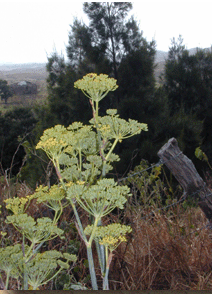Skip to content
Foeniculum vulgare
 PLANT NAME: Foeniculum vulgare Mill.
PLANT NAME: Foeniculum vulgare Mill.
OTHER NAMES: Anethum foeniculum, F. capillaceum, F. officinale.
COMMON NAMES: Fennel [English]; xiao hui xiang [China]; adas [Java, Indonesia]; almindelig [Denmark]; fenchel, fenchle [Germany]; fenikkel [Norway]; fenoll, fonoll [Catalan]; fenouille [France]; finocchio [Italian]; foeniculum, maratrum [Latin]; hinojo [Spain]; inuju [Aymara, Kechua]; jinuchchu [Kallawaya]; koper wloski [Poland]; marathron (“to grow thin”) [Ancient Greek]; mieloi [Basque]; shouikyo [Japan]: sohoehyang [Korea]; sanuf, bari-sanuf [Hindi]; shatapuspha [Sanskrit].
FAMILY: Apiaceae (carrot family).
CATEGORY: Warm the interior, expel cold.
PROPERTIES: Sweet, acrid, neutral to warm [China]. Sweet, bitter, cool to cold [India]. Warm and humid [Mexico].
PLANT PART USED: Mostly the fruit (sometimes called the “seed”).
PREPARATION OF MEDICINE: Infused or decocted. Seeds may be ground, chewed or steeped in tea. Does well in tincture 1:5, 60% alcohol.
MERIDIAN AFFINITIES: Spleen, stomach, liver, kidney.
WESTERN FUNCTIONS REPORTED: Abortifacient; alleviates the symptoms of “male menopause”; analgesic; anodyne [China]; anthelmintic [India (seeds)]; anti-fungal (essential oil); anti-inflammatory; anti-microbial; antipyretic; antiseptic; antispasmodic [India, Mexico]; antitussive; aphrodisiac [China, India (seeds)]; appetizer [India (seeds)]; appetite stimulant; aromatic; astringent; bactericidal (essential oil); balsamic [Japan]; calms the nerves [India]; cardiotonic [Dominican Republic]; carminative [Cherokee, China, Haiti, India, Iraq, Mexico,Turkey]; choleretic; calming for overactive digestive systems; cold remedy [Cherokee]; diaphoretic; digestive; diuretic [Dominican Republic, France, Haiti, Hippocrates, India, Mexico, Turkey]; emmenagogue [Haiti, Hippocrates, Turkey]; estrogenic; expectorant [China, Japan, Mexico, Research, Turkey]; facilitates birth; febrifuge; hallucinogenic; hepatic; hypotensive; increases libido; increases milk secretion; increases peristalsis; increases the digestive flora; lactogogue [China, Haiti, Mexico, Turkey]; laxative [India (seeds)]; mild stimulant; orexigenic; parasiticide [Turkey]; prevents influenza; promotes menstruation; promotes gastrointestinal motility; promotes mental alertness [India]; purgative [India (roots)]; reduces arterial blood pressure (water extraction); regulates the menses [India (seeds)]; respiratory stimulant; restorative [Turkey]; secretagogue; secretolytic; spasmolytic (essential oil); stimulant [Dominican Republic, India, Iraq, Mexico, Turkey]; stomachic [China, Dominican Republic, India (seeds), Japan, Turkey, Venezuela]; stops bleeding [Bermuda]; tonic [Cherokee, China, Kurdistan, Venezuela]; vermicide (essential oil) [Nepal]; weak diuretic (leaves) [India].
TRADITIONAL CHINESE ENERGETIC FUNCTIONS (~ = extrapolated):
1) Regulates the liver qi.
2) Harmonizes the stomach.
3) Warms the kidneys.
4) Removes cold and stops pain.
5) Soothes the urinary bladder~.
6) Benefits the eyes~.
7) Opens the lungs & clears cold phlegm.
OTHER MEDICINAL USES
Used to improve the taste of other medicines. Cholera [China]. Low energy [China]. Longevity. Hernia [China]. Leprosy [India (seeds)]. Parasites. Swallowing air [Haiti]. Fluid discharge [China]. Snake bite [China].
USE AS FOOD:
-
The Romans ate young fennel stalks, and some varieties of fennel are used today as a vegetable. The leaves are used in salads and to flavor fish. The young stems can be used in soups. The cultivated bulbs are often better to eat than the wild crafted ones.
-
Young leaves can be used as a garnish, added to cooked food and salads, or to flavor fish. This can be useful to help digest greasy meals. Leaves can be harvested year round.
-
Seeds can flavor bread stuffing or cakes.
-
Eaten during Lent to allay hunger.
-
Fennel seeds have been used as a juniper substitute for flavoring gin, and are often used for flavoring “licorice” products. In fact, some of my Hawaiian teachers called this plant “licorice”.
-
Fennel has more isoflavones than soy.
-
The smell and taste of fennel is dependant on the proportions of two chemicals. “fenchone,” which is bitter, and “anethole” is sweet.
POSSIBLE DRUG INTERACTIONS: Anethole potentiates streptomycin against tuberculosis in lab animals [Bensky 1986].
TOXICITY: There is no acute toxicity of the ethanol extraction in mice at 0.5 – 3 g / kg or chronic toxicity at 100 mg / kg per day. Interestingly, male mice gained significant weight while undergoing the chronic treatment, but not female mice [Shah 1991].
The oil is toxic to the liver and irritating to the kidneys. An overdose of the volatile oil can cause nausea, vomiting, pulmonary edema, and seizures. 5-20 drops of the oil can trigger convulsions and hallucinations.
CAUTIONS AND CONTRAINDICATIONS:
Not in pregnancy.
Allergic reactions, while rare, can occur with Foeniculum vulgare. 62% of plant coumarins come from the apiaceae family of plants; of which Foeniculum is one genus [Nielsen 1971]. Certain coumarins are known to cause photodermatitis. Fennel is known to cause photodermatitis or contact dermatitis. Those who are allergic to one apiaceae family member are often allergic to others.
Not with estrogen sensitive cancer.
Caution with diverticulitis, diverticulosis, duodenal ulcer, GERD, stomach ulcer, ulcerative colitis.
ENERGETIC CAUTIONS: Caution with yin deficient heat.

 PLANT NAME: Foeniculum vulgare Mill.
PLANT NAME: Foeniculum vulgare Mill.
